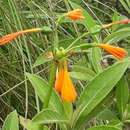Stenomesson is a genus of bulbous plants in the family Amaryllidaceae. All the species are native to western South America (Colombia, Ecuador, Peru and northern Chile).[3][4][5][6][7][8]
Etymology
The generic name Stenomesson references the floral morphology. It is composed of the Greek words stenos, meaning narrow, and meso, meaning "in the middle".[9]
Species
As of February 2021, Plants of the World Online accepted the following species:[10]
-
Stenomesson aurantiacum (Kunth) Herb. - Colombia, Ecuador, Peru
-
Stenomesson breviflorum Herb. - Peru (Junín, Lima)
-
Stenomesson campanulatum Alan Meerow - Peru (Cajamarca, La Libertad)
-
Stenomesson chilense Ravenna - Chile (Tarapacá)
-
Stenomesson chloranthum Meerow & van der Werff - Peru (Amazonas)
-
Stenomesson ecuadorense Meerow, Oleas & L.Jost
-
Stenomesson flavum (Ruiz & Pav.) Herb. - Peru (Cajamarca, Lima, La Libertad, Pasco)
-
Stenomesson gasteroides Ravenna- Peru
-
Stenomesson leucanthum (Ravenna) Meerow & van der Werff - Peru (Cajamarca, La Libertad)
-
Stenomesson miniatum (Herb.) Ravenna - Peru (Cajamarca, Apurimac, Cusco), Bolivia (La Paz)
-
Stenomesson moldenkei Traub - Peru (Lima)
-
Stenomesson parvulum Ravenna - Peru (Cajamarca])
-
Stenomesson pauciflorum (Lindl. ex Hook.) Herb. - Peru (Lima)
-
Stenomesson pearcei Baker - Peru (Junín, Puno, Cusco), Bolivia (La Paz)
-
Stenomesson rupense Ravenna - Peru
-
Stenomesson tubiflorum (Meerow) Meerow
-
Stenomesson vitellinum Lindl. - Peru (Lima)
-
Stenomesson weberbaueri (Vargas) Ravenna - Peru (Cajamarca])
- Formerly included[2]
Numerous names have been coined using the name Stenomesson referring to species now regarded as better suited to other genera (Clinanthus, Eucrosia, Ismene and Urceolina).
References
-
^ 1839 illustration from Edwards's Botanical Register; Consisting of Coloured Figures of Exotic Plants Cultivated in British Gardens; with their History and Mode of Treatment. London 25: t. 68 (1839). As Pentlandia miniata var. sulivanica
-
^ a b Kew World Checklist of Selected Plant Families
-
^ "Stenomesson". The Plant List. Retrieved 9 June 2013.
-
^ León, B., J. Roque, C. Ulloa Ulloa, N. C. A. Pitman, P. M. Jørgensen & A. Cano E. 2006 [2007]. El Libro Rojo de las Plantas Endémicas del Perú. Revista Peruana de Biología 13(núm. 2 especial): 1s–971s.
-
^ Ravenna, P. 1971. Contributions to South American Amaryllidaceae IV. Plant Life 27: 61–89.
-
^ Brako, L. & J. L. Zarucchi. (eds.) 1993. Catalogue of the Flowering Plants and Gymnosperms of Peru. Monographs in systematic botany from the Missouri Botanical Garden 45: i–xl, 1–1286
-
^ Jørgensen, P. M., M. H. Nee & S. G. Beck. (eds.) 2014. Catálogo de las Plantas Vasculares de Bolivia, Monographs in systematic botany from the Missouri Botanical Garden 127(1–2): i–viii, 1–1744.
-
^ Meerow, Alan W. 2000. Phylogeny of the American Amaryllidaceae based on nrDNA ITS sequences Systematic Botany 25(4):708-726
-
^ Weber, O., & Wilkin, P. (2007). 588. STENOMESSON PEARCEI: Amaryllidaceae. Curtis's Botanical Magazine, 24(2), 114-120.
-
^ "Stenomesson Herb.", Plants of the World Online, Royal Botanic Gardens, Kew, retrieved 2021-02-09


